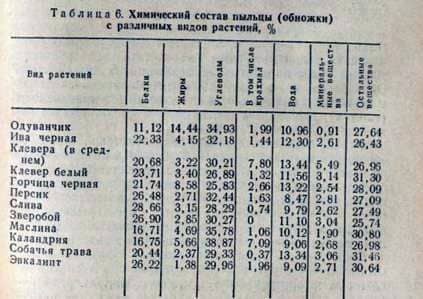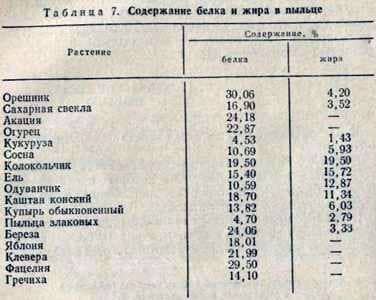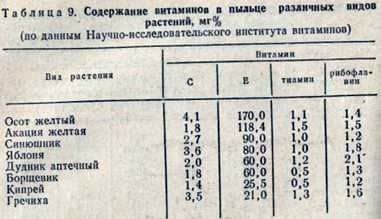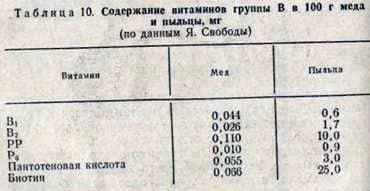
The quality and value of pollen depends on its chemical composition.
Approximately 30% of the composition of pollen is carbohydrate, sugar, a significant part of which the bee is mixed with pollen, so that it becomes sticky and reliably kept on legs during the flight.
The main measure of the value of pollen for bees is the content of protein in it and partly of fat (Table 6).

Summary of the pollen analysis of some plants, most often visited by bees, are given in Table 7. In general, pollen of wind-polluted plants is poorer in protein and fat than pollen of insect-polluted plants.

Of particular importance for the nutritional value of pollen is the presence in it of essential amino acids. It is determined that in a mixture of pollen collected by bees, as a rule, all the essential amino acids (Table 8), which are part of the body of the pupa that no longer consumes food, are contained.

However, the pollen of individual plant species may not contain all amino acids. So, in the pollen of dandelion of the ten irreplaceable amino acids there are three, in the pollen of willow – two. In a mixture of pollen taken from the hive, always found a complete set of all amino acids. This explains the fact that, feeding on a mixture of pollen of different plants, bees grow significantly more larvae than on pollen from only one plant species.
The remaining amino acids belong to the group of interchangeable amino acids, that is, those that can synthesize the organism from other substances. For example, the amino acid of the series is in large numbers in the body of larvae (475 mg%) and much less in adult bees (80 mg%), since it is used to build a chitinous cover.
The quantitative and qualitative composition of amino acids in a mixture of pollen fed to bees is close to the quantitative and qualitative composition of the amino acids of royal jelly obtained from the same family.
Starch and fat in the pollen are mutually complementary. In pollen that contains a lot of fat, there is usually little starch, and vice versa, when the amount of starch is high, there is little fat in it.
Various pollutants were found in the pollen: potassium (0.6-1.0%), phosphorus (0.43%), calcium (0.29%), magnesium (0.25%) copper (1.7 mg%) , iron (0.55 mg%). In addition, silicon, sulfur, chlorine, titanium, manganese, as well as barium, silver, gold, palladium, vanadium, tungsten, iridium, cobalt, zinc, arsenic, tin, platinum, molybdenum, chromium, cadmium, strontium the latter were detected by spectral analysis).
The pollen contains cellulose, which is not digested by bees, from which the shell of pollen grains consists.
Pollen is a rich source of various vitamins (Table 9).

Group B vitamins contain significantly more pollen in pollen than in green vegetables and fruits (Table 10).

Given this, pollen (rejuvenation) is taken from bees in apiaries and is used in medicine as a medicine.
The pollen contains various pigments (mainly carotenoids), enzymes (invertase, amylase, catalase, etc.) and hormones that accelerate and inhibit plant growth, including the known “growth agent” – heteroauxin.
Сухари с медом. Опыление пчелами в теплицах.
Feeding base of beekeeping